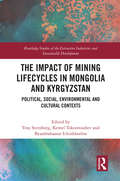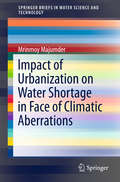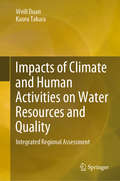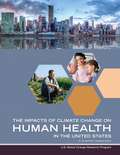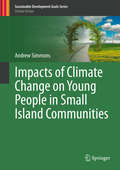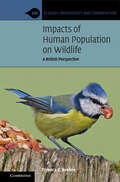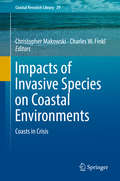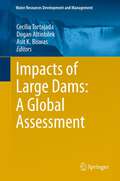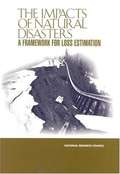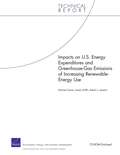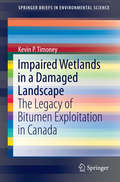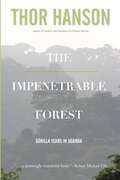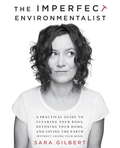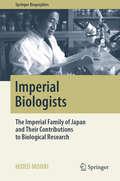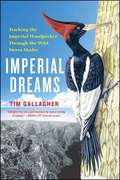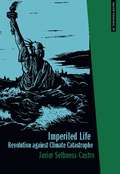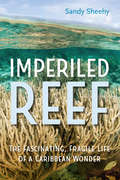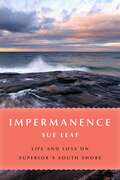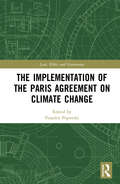- Table View
- List View
The Impact of Mining Lifecycles in Mongolia and Kyrgyzstan: Political, Social, Environmental and Cultural Contexts (Routledge Studies of the Extractive Industries and Sustainable Development)
by Troy SternbergThis volume investigates how mining affects societies and communities in Mongolia and Kyrgyzstan. As ex-Soviet states, Mongolia and Kyrgyzstan share history, culture and transitions to democracy. Most importantly, both are mineral-rich countries on China’s frontier and epi-centres of resource extraction. This volume examines challenges communities in these countries encounter on the long journey through resource exploration, extraction and mine closure. The book is organised into three related sections which travel from mine licensing and instigation to early anticipation of benefit through the realisation of social and environmental impacts to finite issues such as jobs, monitoring, dispute resolution and reclamation. Most originally, each chapter will include a final section entitled ‘Notes from the Field’ that presents the voice of in-country researchers and stakeholders. These sections will provide local contextual knowledge on the chapter’s theme by practitioners from Mongolia and Central Asia. The volume thereby offers a distinctively grounded perspective on the tensions and benefits of mining in this dynamic region. Using Mongolia and Kyrgyzstan as case studies, the volume reflects on the evolving challenges communities and societies encounter with resource extraction worldwide. The book will be of great interest to students and scholars of mining and natural resource extraction, corporate social responsibility and sustainable development.
Impact of Urbanization on Water Shortage in Face of Climatic Aberrations
by Mrinmoy MajumderThe uncontrolled utilization of natural resources to supply to the water demands of the ever-growing population has brought about worldwide scarcity. The supply shortage has resulted in conflicts between countries, created prolonged drought, closing of industrial units, shifting of local inhabitants etc. The abnormality in climatic patterns due to global warming has only enhanced the uncertainties. Unregulated discharge of waste water into fresh water resources is also polluting the available water resources and making them non-utilizable. That is why the discrepancy between water supply and demand is slowly but steadily becoming a problem, which may lead to conflict and inequality all over the world. The present investigation is an attempt to find the impact of urbanization in the face of climatic uncertainties on water shortage or scarcity. How is climate responsible? What urbanization factors have an influence on the extent of shortages? What is the role of the socio-economic status of the inhabitants? Industrialization? Consumption pattern? Each of the causes and effects were analyzed with the help of data from a climate model, which was then fed into a hydrologic model. The hydrologic output data was then put into various other novel simulation platforms to predict the uncertainties that can be caused by urbanization in various sectors of the regions of interest. The impact was calculated based on IPCC recommended climatic and five distinct urbanization scenarios. The study results will help to predict what is in store of those living in the developing countries. Possible mitigation measures are also discussed.
Impacts of Climate and Human Activities on Water Resources and Quality: Integrated Regional Assessment (Springer Geography Ser.)
by Weili Duan Kaoru TakaraWith the rapid increase of world population, the global water shortage is set to be the major crises of the twenty-first century; that is, population dynamics (growth, age distribution, urbanization and migration) create pressures on freshwater resources due to the increased water demands and pollution. Moreover, water resources management faces a new uncertainty- i.e. the potential for longer-term and more persistent climate change nowadays, which, in coming years, may significantly affect the availability of supply and patterns of water demand. This book mainly focuses on the impact of climate change and human activities on water quality and water resources in Asia Countries. It begins by describing the characteristics of water related disasters in the world. Then, the book analyzes the changes of floods and associated socio-economic damages for whole China over the last century, and assesses water quality and pollution source for the Yangtze River Basin, suggesting water-related disasters would become more intense, longer lasting, and/or more frequent in a future warmer climate. Then, after investigating spatiotemporal trends and causes of water quality and water quality incidents (Chapter 4) and precipitation extreme events (Chapter 5) in Japan, subsequent two chapters mainly evaluate the climate and human impacts on precipitation variations, water quality and water resources in the Hokkaido area. The final chapter comprehensively analyzes climate change impacts on water resources in the Aral Sea Basin, and then estimate the water requirements and water deficits for irrigation, future agricultural yields of seven major crops, and land and water productivity in four provinces of Turkmenistan considering climate change, population growth, and three socio-economic development scenarios. All results obtained from this book may provide a means to reduce water quality incidents and mitigate future negative impacts by adapting water management. Furthermore, the improved methods for water quality modeling in data scarce regions are transferable to other study areas and applicable in future research.
Impacts of Climate Change on Allergens and Allergic Diseases
by Paul J. BeggsClimate change has been identified as the biggest global health threat of the twenty-first century. Hundreds of millions of people around the world currently suffer from allergic diseases such as asthma and allergic rhinitis (hay fever), and the prevalence of these diseases is increasing. This book is the first authoritative and comprehensive assessment of the many impacts of climate change on allergens, such as pollen and mould spores, and allergic diseases. The international authorship team of leaders in this field explore the topic to a breadth and depth far beyond any previous work. This book will be of value to anyone with an interest in climate change, environmental allergens, and related allergic diseases. It is written at a level that is accessible for those working in related physical, biological, and health and medical sciences, including researchers, academics, clinicians, and advanced students.
Impacts of Climate Change on Human Health in the United States: A Scientific Assessment
by US Global Research ProgramAs global climate change proliferates, so too do the health risks associated with the changing world around us. Called for in the President’s Climate Action Plan and put together by experts from eight different Federal agencies, The Impacts of Climate Change on Human Health: A Scientific Assessment is a comprehensive report on these evolving health risks, including: Temperature-related death and illnessAir quality deteriorationImpacts of extreme events on human healthVector-borne diseasesClimate impacts on water-related IllnessFood safety, nutrition, and distributionMental health and well-being This report summarizes scientific data in a concise and accessible fashion for the general public, providing executive summaries, key takeaways, and full-color diagrams and charts. Learn what health risks face you and your family as a result of global climate change and start preparing now with The Impacts of Climate Change on Human Health.
Impacts of Climate Change on Young People in Small Island Communities (Sustainable Development Goals Series)
by Andrew SimmonsThis book presents a comprehensive overview of the history, definition, causes, effects, impacts and implications of climate change on young people globally, with a focus on Small Island Communities (SIDS) in particular. The text highlights the key problems associated with the impact of climate change on young people in SIDS, specifically its effects on socio-economic development and livelihoods, and explores the need for the development of a new conceptual framework to deal with building the resilience of the adaptive capacity of youth in SIDS. The book analyzes the strengths and weaknesses of the emerging phenomenon of Global Youth Climate Change Movements/Actions, and examines the management/governance challenges associated with the Movement in terms of its operational mechanism, mobilization strategies and its use of social media/technology to mobilize mass action. The text concludes with a recommendation for further research in this area as a way to understand how the Movement functions and its mechanism for implementation of future research.
Impacts of Human Population on Wildlife: A British Perspective (Ecology, Biodiversity and Conservation)
by Trevor J. BeebeeWildlife and the countryside are highly valued by people in the UK, and for good reason. Healthy habitats are invaluable assets and promote human wellbeing. However, they are under increasing threat from, among other things, relentless urban expansion and intensive modern agriculture. These pressures largely stem from a major underlying cause – the high and growing population of humans living in the UK. This book provides an overview of wildlife in the UK and its recent status; factors contributing to wildlife declines; trends in human numbers; international deliberations about the impacts of human population growth; and the implications for the future of wildlife conservation in the UK. The evidence-based text includes comparisons of wildlife declines and their causes in other countries, providing a global perspective. This book is for ecologists, naturalists and conservation biologists studying and working in academia or in consultancies, as well as all those interested in wildlife conservation.
Impacts of Invasive Species on Coastal Environments: Coasts in Crisis (Coastal Research Library #29)
by Christopher Makowski Charles W. FinklThis book focuses on the global threats to coastal environments from invasive, non-native species and examines how these alien biological species adversely alter landscapes and socioeconomic conditions as well as the psychological attitudes and perceptions of local inhabitants and tourists. Designed for the professional or specialist in marine science, coastal zone management, biology, and related disciplines, this volume appeals to those not only working directly with invasive flora and fauna species, but also those individuals involved in a wide array of coastal related fields. Examples and case studies of coastal invasive species are drawn from many different geographic areas worldwide, including North and South America, Europe, Oceania, the Caribbean, Southeast Asia, and Africa.
Impacts of Large Dams: A Global Assessment
by Cecilia Tortajada Dogan Altinbilek Asit K. BiswasOne of the most controversial issues of the water sector in recent years has been the impacts of large dams. Proponents have claimed that such structures are essential to meet the increasing water demands of the world and that their overall societal benefits far outweight the costs. In contrast, the opponents claim that social and environmental costs of large dams far exceed their benefits, and that the era of construction of large dams is over. A major reason as to why there is no consensus on the overall benefits of large dams is because objective, authoritative and comprehensive evaluations of their impacts, especially ten or more years after their construction, are conspicuous by their absence. This book debates impartially, comprehensively and objectively, the positive and negative impacts of large dams based on facts, figures and authoritative analyses. These in-depth case studies are expected to promote a healthy and balanced debate on the needs, impacts and relevance of large dams, with case studies from Africa, Asia, Australia, Europe and Latin America.
The Impacts of Natural Disasters: A Framework for Loss Estimation
by National Research CouncilWe in the United States have almost come to accept natural disasters as part of our nation's social fabric. News of property damage, economic and social disruption, and injuries follow earthquakes, fires, floods and hurricanes. Surprisingly, however, the total losses that follow these natural disasters are not consistently calculated. We have no formal system in either the public or private sector for compiling this information. The National Academies recommends what types of data should be assembled and tracked.
Impacts on U.S. Energy Expenditures and Greenhouse-Gas Emissions of Increasing Renewable-Energy Use
by Michael Toman Robert J. Lempert James GriffinHow could producing 25 percent of U.S. electricity and motor-vehicle transportation fuels from renewables by the year 2025 affect U.S. consumer energy expenditures and CO2 emissions? This report finds that reaching 25 percent renewables with limited impact on expenditures requires significant progress in renewable-energy technologies and biomass production. Without substantial innovation in these areas, expenditures could increase considerably.
Impaired Wetlands in a Damaged Landscape
by Kevin P. TimoneyThis work is a scientific monograph that examines the flora and vegetation of natural mineral wetlands in comparison to mineral wetlands affected by bitumen exploitation. The work is of broad relevance because (a) wetland loss and degradation is a global problem; (b) the continued global increase in fossil fuel exploitation is resulting in widespread damage; and (c) bitumen (tar sands, oil sands) exploitation is a rapidly growing and destructive set of activities. The core of the work is a meta-analysis of 417 vegetation plots. Analyses of change over time and chemical and physical attributes of water and soil are presented for the subset of plots with sufficient data. The purpose of the work is to demonstrate that: (1) There are marked differences between natural and industrially-affected wetlands. (2) Industrially-affected mineral wetlands differ from natural wetlands in their vegetation assemblages, their depressed vegetation and species diversity, and their abundance of exotic weeds. (3) Successful post-bitumen mining wetland reclamation has not been accomplished and may not be attainable within the foreseeable future given the ecological and physical conditions of the industrial wetlands, current reclamation practices, and lax regulatory standards. In regard to government policy and industrial practices, it finds that they are responsible for reclamation failure on a grand scale.
The Impenetrable Forest: My Gorilla Years in Uganda
by Thor HansonLying in the remote hills of southwest Uganda, Bwindi Impenetrable Forest harbors elephants, chimpanzees, monkeys, and half the world’s population of endangered mountain gorillas. For two years, Thor Hanson called that forest home, working with local guides and trackers to develop an ecotourism program for the newly-formed Bwindi Impenetrable National Park. Thoroughly researched and beautifully told, Hanson’s story blends natural history with cultural insight to place the forest and the gorillas in the context of modern Africa. The Impenetrable Forest offers a rare glimpse into the world of mountain gorillas, and the human cultures that surround them. A must-read for anyone interested in primates, gorilla tracking, endangered species conservation, or travel to Uganda.
The Imperatives of Sustainable Development: Needs, Justice, Limits
by Erling Holden Kristin Linnerud David Banister Valeria Jana Schwanitz August WierlingThirty years ago, the UN report Our Common Future placed sustainable development firmly on the international agenda. The Imperatives of Sustainable Development takes the ethical foundations of Our Common Future and builds a model that emphasizes three equally important moral imperatives – satisfying human needs, ensuring social justice, and respecting environmental limits. This model suggests sustainability themes and assigns thresholds to them, thereby defining the space within which sustainable development can be achieved. The authors accept that there is no single pathway to the sustainable development space. Different countries face different challenges and must follow different pathways. This perspective is applied to all countries to determine whether the thresholds of the sustainability themes selected have been met, now and in the past. The authors build on the extensive literature on needs, equity, justice, environmental science, ecology, and economics, and show how the three moral imperatives can guide policymaking. The Imperatives of Sustainable Development synthesizes past reasoning, summarizes the present debate, and provides a clear direction for future thinking. This book will be essential reading for everyone interested in the future of sustainable development and in the complex environmental and social issues involved.
Imperfect Balance: Landscape Transformations in the Pre-Columbian Americas
by David L. LentzWe often envision the New World before the arrival of the Europeans as a land of pristine natural beauty and undisturbed environments. However, David Lentz offers an alternative view by detailing the impact of native cultures on these ecosystems prior to their contact with Europeans. Drawing on a wide range of experts from the fields of paleoclimatology, historical ecology, paleontology, botany, geology, conservation science, and resource management, this book unlocks the secret of how the Western Hemisphere's indigenous inhabitants influenced and transformed their natural environment. A rare combination of collaborators uncovers the changes that took place in North America, Mexico, Central America, the Andes, and Amazonia. Each section of the book has been comprehensively arranged so that a botanical description of the natural vegetation of the region is coupled with a set of case studies outlining local human influences. From modifications of vegetation, to changes in soil, wildlife, microclimate, hydrology, and the land surface itself, this collection addresses one of the great issues of our time: the human modification of the earth.
Imperfect Balance: Landscape Transformations in the Pre-Columbian Americas (Historical Ecology Series)
by Lentz David L. Ed.We often envision the New World before the arrival of the Europeans as a land of pristine natural beauty and undisturbed environments. However, David Lentz offers an alternative view by detailing the impact of native cultures on these ecosystems prior to their contact with Europeans. Drawing on a wide range of experts from the fields of paleoclimatology, historical ecology, paleontology, botany, geology, conservation science, and resource management, this book unlocks the secret of how the Western Hemisphere's indigenous inhabitants influenced and transformed their natural environment.A rare combination of collaborators uncovers the changes that took place in North America, Mexico, Central America, the Andes, and Amazonia. Each section of the book has been comprehensively arranged so that a botanical description of the natural vegetation of the region is coupled with a set of case studies outlining local human influences. From modifications of vegetation, to changes in soil, wildlife, microclimate, hydrology, and the land surface itself, this collection addresses one of the great issues of our time: the human modification of the earth.
The Imperfect Environmentalist
by Sara GilbertActress, producer, mother, and imperfect environmentalist, Sara Gilbert understands how helping the environment can seem overwhelming. Between keeping up with work, friends, and kids, who has the time or money to maintain a compost pile, become an activist, or knit a sweater out of recycled grocery bags? Fortunately, we now know that small changes here and there in our everyday lives can make a big impact on the environment. We just need to know where to begin. That's where Gilbert comes in, with this tongue-in-cheek reference guide packed full of helpful information, available at your fingertips. Read it cover to cover or just open it up to a random page; you can take what you want from it when you want. Whether you've got money to burn or have to crash on a friend's couch, here are all of the eco-essentials to get the planet back on track, and you won't have to hug a single tree--unless tree-hugging is your thing. Sharing the basics on health and beauty, work and money, home and gardening, family and fitness, and more, The Imperfect Environmentalist cuts through the clutter--both in our homes and in our heads--and offers simple approaches to help us clear out the pollutants, put down the poisons, and begin to breathe easy again--one 100% recycled page at a time.Advance praise for The Imperfect Environmentalist "This book really opened my eyes. Then my eyes started stinging and tearing from all the toxins in the environment I'm now aware of. Thanks, Sara, I have a lot to do now."--Lisa Kudrow "Sara's passion and commitment to the environment have given me an awareness that I never had before about our planet. I learn from Sara every day and she makes me want to be a better person. See, you can teach an old dog new tricks."--Sharon OsbourneFrom the Trade Paperback edition.
Imperial Ambitions: Conversations on the Post-9/11 World
by Noam Chomsky David Barsamian[From the book cover] Timely, illuminating, and urgently needed, this volume of interviews conducted by award-winning radio journalist David Barsamian features Noam Chomsky discussing U.S. policies in the increasingly unstable post-9/11 world. In these exchanges, appearing for the first time in print, Chomsky offers his frank, provocative, and informed views on the invasion and occupation of Iraq, the doctrine of preemptive strikes against so-called rogue states, and the growing threat to international peace posed by the U.S. drive for domination. In his inimitable style, Chomsky also dissects the propaganda system that fabricates a mythic past and airbrushes inconvenient facts out of history.
Imperial Biologists: The Imperial Family of Japan and Their Contributions to Biological Research (Springer Biographies)
by Hideo MohriThis book sheds light on a little-known aspect of the Imperial family of Japan: For three generations, members of the family have devoted themselves to biological research. Emperor Showa (Hirohito) was an expert on hydrozoans and slime molds. His son, Emperor Akihito, is an ichthyologist specializing in gobioid fishes, and his research is highly respected in the field. Prince Akishino, Emperor Akihito’s son, is known for his research on giant catfish and the domestication of fowl, while Prince Hitachi, Emperor Akihito’s brother, has conducted research on cancer in animals.The book shows how they became interested in biology, how seriously they were committed to their research, what their main scientific contributions are, and how their achievements are valued by experts at home and abroad.To commemorate the 60-year reign of Emperor Showa and his longtime devotion to biology, the International Prize for Biology was founded in 1985. The prize seeks to recognize and encourage researches in basic biology. A list of winners and a summary of their research are presented in the last part of the book.The author, an eminent biologist who has given lectures to the Imperial Family, explains their research and tells the fascinating story of biology and the Imperial Family of Japan. The book is a valuable resource, not only for biology students and researchers, but also for historians and anyone interested in science and the Royal and Imperial families.
Imperial Dreams: Tracking the Imperial Woodpecker Through the Wild Sierra Madre
by Tim GallagherA decade ago, Tim Gallagher was one of the rediscoverers of the legendary ivory-billed woodpecker, which most scientists believed had been extinct for more than half a century—now Gallagher once again hits the trail, journeying deep into Mexico&’s savagely beautiful Sierra Madre Occidental, home to rich wildlife, as well as to Mexican drug cartels, in a perilous quest to locate the most elusive bird in the world—the imperial woodpecker.The imperial woodpecker&’s trumpetlike calls and distinctive hammering on massive pines once echoed through the high forests. Two feet tall, with deep black plumage, a brilliant snow-white shield on its back, and a crimson crest, the imperial woodpecker had largely disappeared fifty years ago, though reports persist of the bird still flying through remote mountain stands. In an attempt to find and protect the imperial woodpecker in its last habitat, Gallagher is guided by a map of sightings of this natural treasure of the Sierra Madre, bestowed on him by a friend on his deathbed. Charged with continuing the quest of a line of distinguished naturalists, including the great Aldo Leopold, Gallagher treks through this mysterious, historically untamed and untamable territory. Here, where an ancient petroglyph of the imperial can still be found, Geronimo led Apaches in their last stand, William Randolph Hearst held a storied million-acre ranch, and Pancho Villa once roamed, today ruthless drug lords terrorize residents and steal and strip the land. Gallagher&’s passionate quest takes a harrowing turn as he encounters armed drug traffickers, burning houses, and fleeing villagers. His mission becomes a life-and-death drama that will keep armchair adventurers enthralled as he chases truth in the most dangerous of habitats.
Imperiled Life
by Javier SethnessImperiled Life theorizes an exit from the potentially terminal consequences of capital-induced climate change. It is a collection of reflections on the phenomenon of catastrophe--climatological, political, social--as well as on the possibilities of overcoming disaster. Javier Sethness-Castro presents the grim news from contemporary climatologists while providing a reconstructive vision inspired by anarchist intellectual traditions and promoting critical thought as a means of changing our historical trajectory. Javier Sethness-Castro is a libertarian socialist and a rights advocate. Imperiled Life is his first book.
Imperiled Ocean: Human Stories From A Changing Sea
by Laura TretheweyAn exploration of the earth's last wild frontier, filled with high-stakes stories that explores a vast territory undergoing tremendous change and the people and places facing an uncertain future. On a life raft in the Mediterranean, a teenager from Ghana wonders whether he will reach Europe alive, and if he does, whether he will be allowed to stay. In the North Atlantic, a young chef disappears from a cruise ship, leaving a mystery for his friends and family to solve. A water-squatting community battles eviction from a harbor in a Pacific Northwest town, raising the question of who owns the water. Imperiled Ocean by ocean journalist Laura Trethewey is a deeply reported work of narrative journalism that follows people as they head out to sea. What they discover holds inspiring and dire implications for the life of the ocean — and for all of us back on land. As Imperiled Ocean unfolds, battles are fought, fortunes made, lives lost, and the ocean approaches an uncertain future. Behind this human drama, the ocean is growing ever more unstable, threatening to upend life on land. As we explore with Tretheway, we meet biologist Erin Stoddard tracking sturgeon in the Pacific Northwest. Unable to stop the development and pollution destroying the fish’s habitat, Stoddard races to learn about the fish before it disappears. This prehistoric fish has survived more than 300 million years on earth and could hold important truths about how humanity might make itself amenable to a changing ocean. As a fisher and scientist, Erin’s ability to listen to the water becomes a parable for what faces the ocean today. By eavesdropping on an imperiled world, he shows a way we can move forward to save the oceans we all share—through listening and discovery.
Imperiled Reef: The Fascinating, Fragile Life of a Caribbean Wonder
by Sandy SheehyThe beauty and drama of a world beneath the surface of the waves This book brings alive the richly diverse world of an underwater paradise: the Mesoamerican Barrier Reef. Stretching 625 miles through the Caribbean Sea along the coasts of Mexico, Belize, Guatemala, and Honduras, this reef is the second largest coral structure on the planet. Imperiled Reef searches out the breathtaking intricacies of this endangered ecological treasure. Research shows that the future of the reef is at risk, Sheehy explains. Looking closely at threats ranging from global warming to overfishing to irresponsible development, Sheehy draws attention to the inspiring efforts of nongovernmental agencies, scientists, and local communities who are working together to address these challenges. She includes practical actions individuals can take to protect this reef—as well as marine ecosystems everywhere. Celebrating a vast, submerged landscape that has too often been undervalued, Imperiled Reef is both a strong case for protecting an international marvel and a powerful message of hope for the world’s oceans.
Impermanence: Life and Loss on Superior's South Shore
by Sue LeafA personal journey through the ever-changing natural and cultural history of Lake Superior&’s South Shore Lake Superior&’s South Shore is as malleable as it is enduring, its red sandstone cliffs, clay bluffs, and golden sand beaches reshaped by winds and water from season to season—and sometimes from one hour to the next. Generations of people have inhabited the South Shore, harvesting the forests and fish, mining copper, altering the land for pleasure and profit, for better or worse. In Impermanence, author Sue Leaf explores the natural and human histories that make the South Shore what it is, from the gritty port city of Superior, Wisconsin, to the shipping locks at Sault Ste. Marie, Michigan. For Leaf, what began as a bicycling adventure on the coast of Lake Superior in 1977 turned into a lifelong connection with the area, and her experience, not least as owner of a rustic cabin on a rapidly eroding lakeside cliff, imbues these essays with a passionate sense of place and an abiding curiosity about its past and precarious future. As waves slowly consume the shoreline where her family has spent countless summers, Leaf is forced to confront the complexity of loving a place that all too quickly is being reclaimed by the great lake. Impermanence is a journey through the South Shore&’s story, from the early days of the Anishinaabe and fur traders through the heyday of commercial fishing, lumber camps, and copper mining on the Keweenaw Peninsula to the awakening of the Northland to the perils and consequences of plundering its natural splendor. Noting the geological, ecological, and cultural features of each stop on her tour along the South Shore, Leaf writes about the restoration of the heavily touristed Apostle Islands National Lakeshore to its pristine conditions, even as Lake Superior maintains its allure for ice fishers, kayakers, and long-distance swimmers. She describes efforts to protect the endangered piping plover and to preserve the diverse sand dunes on the Michigan coast, and she observes the slough that supports rare intact wild rice beds central to Anishinaabe culture. Part memoir, part travelogue, part natural and cultural history, Leaf&’s love letter to Lake Superior&’s South Shore is an invitation to see this liminal world in all its seasons and guises, to appreciate its ageless, ever-changing wonders and intimate charms.
The Implementation of the Paris Agreement on Climate Change (Law, Ethics and Governance)
by Vesselin PopovskiIn December 2015, 196 parties to the United Nations Framework Convention on Climate Change (UNFCCC) adopted the Paris Agreement, seen as a decisive landmark for global action to stop human- induced climate change. The Paris Agreement will replace the 1997 Kyoto Protocol which expires in 2020, and it creates legally binding obligations on the parties, based on their own bottom-up voluntary commitments to implement Nationally Determined Contributions (NDCs). The codification of the climate change regime has advanced well, but the implementation of it remains uncertain. This book focuses on the implementation prospects of the Agreement, which is a challenge for all and will require a fully comprehensive burden- sharing framework. Parties need to meet their own NDCs, but also to finance and transfer technology to others who do not have enough. How equity- based and facilitative the process will be, is of crucial importance. The volume examines a broad range of issues including the lessons that can be learnt from the implementation of previous environmental legal regimes, climate policies at national and sub-national levels and whether the implementation mechanisms in the Paris Agreement are likely to be sufficient. Written by leading experts and practitioners, the book diagnoses the gaps and lays the ground for future exploration of implementation options. This collection will be of interest to policy-makers, academics, practitioners, students and researchers focusing on climate change governance.
